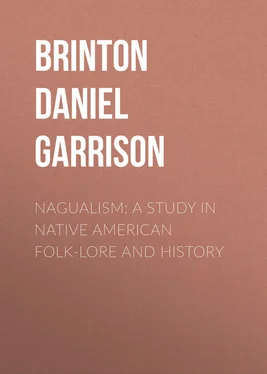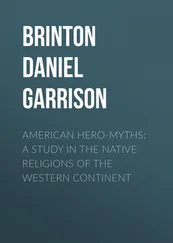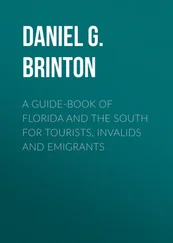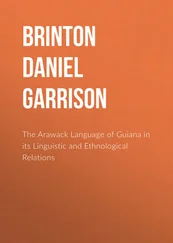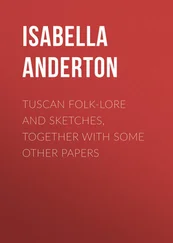Daniel Brinton - Nagualism - A Study in Native American Folk-lore and History
Здесь есть возможность читать онлайн «Daniel Brinton - Nagualism - A Study in Native American Folk-lore and History» — ознакомительный отрывок электронной книги совершенно бесплатно, а после прочтения отрывка купить полную версию. В некоторых случаях можно слушать аудио, скачать через торрент в формате fb2 и присутствует краткое содержание. ISBN: , Жанр: foreign_antique, foreign_prose, на английском языке. Описание произведения, (предисловие) а так же отзывы посетителей доступны на портале библиотеки ЛибКат.
- Название:Nagualism: A Study in Native American Folk-lore and History
- Автор:
- Жанр:
- Год:неизвестен
- ISBN:http://www.gutenberg.org/ebooks/26426
- Рейтинг книги:4 / 5. Голосов: 1
-
Избранное:Добавить в избранное
- Отзывы:
-
Ваша оценка:
- 80
- 1
- 2
- 3
- 4
- 5
Nagualism: A Study in Native American Folk-lore and History: краткое содержание, описание и аннотация
Предлагаем к чтению аннотацию, описание, краткое содержание или предисловие (зависит от того, что написал сам автор книги «Nagualism: A Study in Native American Folk-lore and History»). Если вы не нашли необходимую информацию о книге — напишите в комментариях, мы постараемся отыскать её.
Nagualism: A Study in Native American Folk-lore and History — читать онлайн ознакомительный отрывок
Ниже представлен текст книги, разбитый по страницам. Система сохранения места последней прочитанной страницы, позволяет с удобством читать онлайн бесплатно книгу «Nagualism: A Study in Native American Folk-lore and History», без необходимости каждый раз заново искать на чём Вы остановились. Поставьте закладку, и сможете в любой момент перейти на страницу, на которой закончили чтение.
Интервал:
Закладка:
It is obvious that this method of fortune-telling was most auspicious for the lovers; for I doubt if there is any combination of two numbers below fourteen which is divisible by two, three, four, five and six without remainder in any one instance. 32 32 Juan de Cordova, Arte en Lengua Zapoteca , pp. 16, 202, 203, 213, 216.
The Zapotecs were one of those nations who voluntarily submitted themselves to the Spaniards, not out of love for the Europeans, but through hatred of the Aztecs, who had conquered them in the preceding century. Their king, Coyopy, and his subjects accepted Christianity and were generally baptized; but it was the merest formality, and years afterwards Coyopy was detected secretly conducting the heathen ritual of his ancestors with all due pomp. He was arrested, sent to the city of Mexico, deprived of his power and wealth, and soon died; it is charitably supposed, from natural causes. There is no question but that he left successors to the office of pontifex maximus, and that they continued the native religious ceremonies.
12.The sparse notices we have of the astrology of the Mixtecs, neighbors and some think relatives of the Zapotecs, reveal closely similar rites. The name of their king, who opposed Montezuma the First some sixty years before the arrival of Cortez, proves that they made use of the same or a similar calendar in bestowing personal appellations. It is given as Tres Micos , Three Monkeys.
Unfortunately, so far as I know, there has not been published, and perhaps there does not exist, an authentic copy of the Mixtec calendar. It was nevertheless reduced to writing in the native tongue after the conquest, and a copy of it was seen by the historian Burgoa in the Mixtec town of Yanhuitlan. 33 33 Quoted in Carriedo, ubi suprá, p. 17.
Each day was named from a tree, a plant or an animal, and from them the individual received his names, as Four Lions, Five Roses, etc. (examples given by Herrera). This latter writer adds that the name was assigned by the priests when the child was seven years old (as among the Tzentals), part of the rite being to conduct it to the temple and bore its ears. He refers also to their auguries relating to marriage. 34 34 Hist. de las Indias Oc. , Dec. iii, Lib. iii, cap. 12.
These appear to have been different from among the Zapotecs. It was necessary that the youth should have a name bearing a higher number than that of the maiden, and also “that they should be related;” probably this applied only to certain formal marriages of the rulers which were obliged to be within the same gens .
13.I have referred in some detail to the rites and superstitions connected with the Calendar because they are all essential parts of Nagualism, carried on far into Christian times by the priests of this secret cult, as was fully recognized by the Catholic clergy. Wherever this calendar was in use, the Freemasonry of Nagualism extended, and its ritual had constant reference to it. Our fullest information about it does not come from central Mexico, but further south, in the region occupied by the various branches of the Mayan stock, by the ancestors of some one of which, perhaps, this singular calendar, and the symbolism connected with it, were invented.
One of the most important older authorities on this subject is Francisco Nuñez de la Vega, a learned Dominican, who was appointed Bishop of Chiapas and Soconusco in 1687, and who published at Rome, in 1702, a stately folio entitled “ Constituciones Diœcesanas del Obispado de Chiappa ,” comprising discussions of the articles of religion and a series of pastoral letters. The subject of Nagualism is referred to in many passages, and the ninth Pastoral Letter is devoted to it. As this book is one of extreme rarity, I shall make rather lengthy extracts from it, taking the liberty of condensing the scholastic prolixity of the author, and omitting his professional admonitions to the wicked.
He begins his references to it in several passages of his Introduction or Preambulo , in which he makes some interesting statements as to the use to which the natives put their newly-acquired knowledge of writing, while at the same time they had evidently not forgotten the ancient method of recording ideas invented by their ancestors.
The Bishop writes:
“The Indians of New Spain retain all the errors of their time of heathenism preserved in certain writings in their own languages, explaining by abbreviated characters and by figures painted in a secret cypher 35 35 So I understand the phrase, “figuras pintadas con zifras enigmaticas”
the places, provinces and names of their early rulers, the animals, stars and elements which they worshiped, the ceremonies and sacrifices which they observed, and the years, months and days by which they predicted the fortunes of children at birth, and assign them that which they call the Naguals. These writings are known as Repertories or Calendars, and they are also used to discover articles lost or stolen, and to effect cures of diseases. Some have a wheel painted in them, like that of Pythagoras, described by the Venerable Bede; others portray a lake surrounded by the Naguals in the form of various animals. Some of the Nagualist Masters claim as their patron and ruler Cuchulchan, and they possessed a certain formula of prayer to him, written in the Popoluca tongue (which was called Baha in their time of heathenism), and which has been translated into Mexican. 36 36 Popoluca was a term applied to various languages. I suspect the one here referred to was the Mixe. See an article by me, entitled “Chontales and Popolucas; a Study in Mexican Ethnography,” in the Compte Rendu of the Eighth Session of the Congress of Americanists, p. 566, seq.
“Those who are selected to become the masters of these arts are taught from early childhood how to draw and paint these characters, and are obliged to learn by heart the formulas, and the names of the ancient Nagualists, and whatever else is included in these written documents, many of which we have held in our hands, and have heard them explained by such masters whom we had imprisoned for their guilt, and who had afterwards become converted and acknowledged their sins.” 37 37 Constit. Diocesan , p. 19.
The Bishop made up his mind that extreme measures should be taken to eradicate these survivals of the ancient paganism in his diocese, and he therefore promulgated the following order in the year 1692:
“And because in the provinces of our diocese those Indians who are Nagualists adore their naguals , and look upon them as gods, and by their aid believe that they can foretell the future, discover hidden treasures, and fulfill their dishonest desires: we, therefore, prescribe and command that in every town an ecclesiastical prison shall be constructed at the expense of the church, and that it be provided with fetters and stocks (con grillos y cepos), and we confer authority on every priest and curate of a parish to imprison in these gaols whoever is guilty of disrespect toward our Holy Faith, and we enjoin them to treat with especial severity those who teach the doctrines of Nagualism (y con rigor mayor á los dogmatizantes Nagualistas).” 38 38 Constitut. Diocesan , Titulo vii, pp. 47, 48.
In spite of these injunctions it is evident that he failed to destroy the seeds of what he esteemed this dangerous heresy in the parishes of his diocese; for his ninth Pastoral Letter, in which he exposes at length the character of Nagualism, is dated from the metropolitan city of Ciudad Real, on May 24, 1698. As much of it is germane to my theme, I translate as follows:
“There are certain bad Christians of both sexes who do not hesitate to follow the school of the Devil, and to occupy themselves with evil arts, divinations, sorceries, conjuring, enchantments, fortune-telling, and other means to forecast the future.
Читать дальшеИнтервал:
Закладка:
Похожие книги на «Nagualism: A Study in Native American Folk-lore and History»
Представляем Вашему вниманию похожие книги на «Nagualism: A Study in Native American Folk-lore and History» списком для выбора. Мы отобрали схожую по названию и смыслу литературу в надежде предоставить читателям больше вариантов отыскать новые, интересные, ещё непрочитанные произведения.
Обсуждение, отзывы о книге «Nagualism: A Study in Native American Folk-lore and History» и просто собственные мнения читателей. Оставьте ваши комментарии, напишите, что Вы думаете о произведении, его смысле или главных героях. Укажите что конкретно понравилось, а что нет, и почему Вы так считаете.
